Behavior Assessment: Leadership and Organizational Culture at ADIB
VerifiedAdded on 2023/01/23
|15
|3808
|35
Essay
AI Summary
This essay evaluates Hussein Mohammed's leadership at ADIB, focusing on his transformational leadership style and its effects on organizational culture since 2014. The analysis examines how Mohammed's leadership, characterized by innovation, situational awareness, and employee empowerment, has influenced ADIB's operational strategies and employee behavior. The essay explores the implementation of self-governing thinking, transformational leadership phases (inspiration, motivation, intellectual stimulation, and personalized consideration), and the importance of employee well-being. Furthermore, it discusses the organizational culture of ADIB, highlighting innovation, hands-on approaches, openness, and the small-company-family dynamic. The essay also provides recommendations to enhance the organizational culture, such as improved information sharing and inventive platforms to support personalized functions among individual workers. The essay concludes with an analysis of how Mohammed's leadership style has shaped ADIB's values and principles, ultimately contributing to the company's success. The essay also discusses the importance of employee motivation using Maslow’s hierarchy of needs theory.
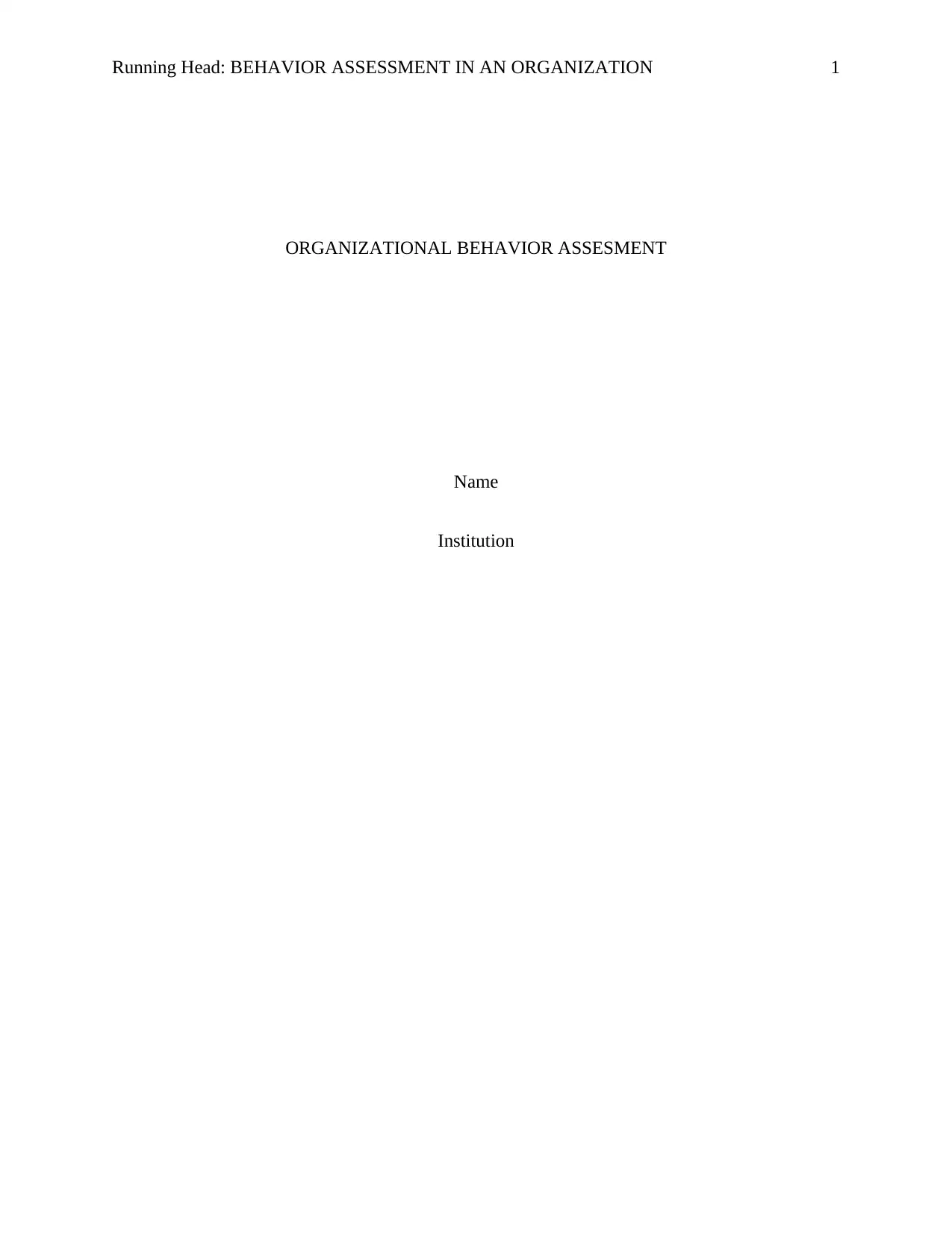
Running Head: BEHAVIOR ASSESSMENT IN AN ORGANIZATION 1
ORGANIZATIONAL BEHAVIOR ASSESMENT
Name
Institution
ORGANIZATIONAL BEHAVIOR ASSESMENT
Name
Institution
Paraphrase This Document
Need a fresh take? Get an instant paraphrase of this document with our AI Paraphraser
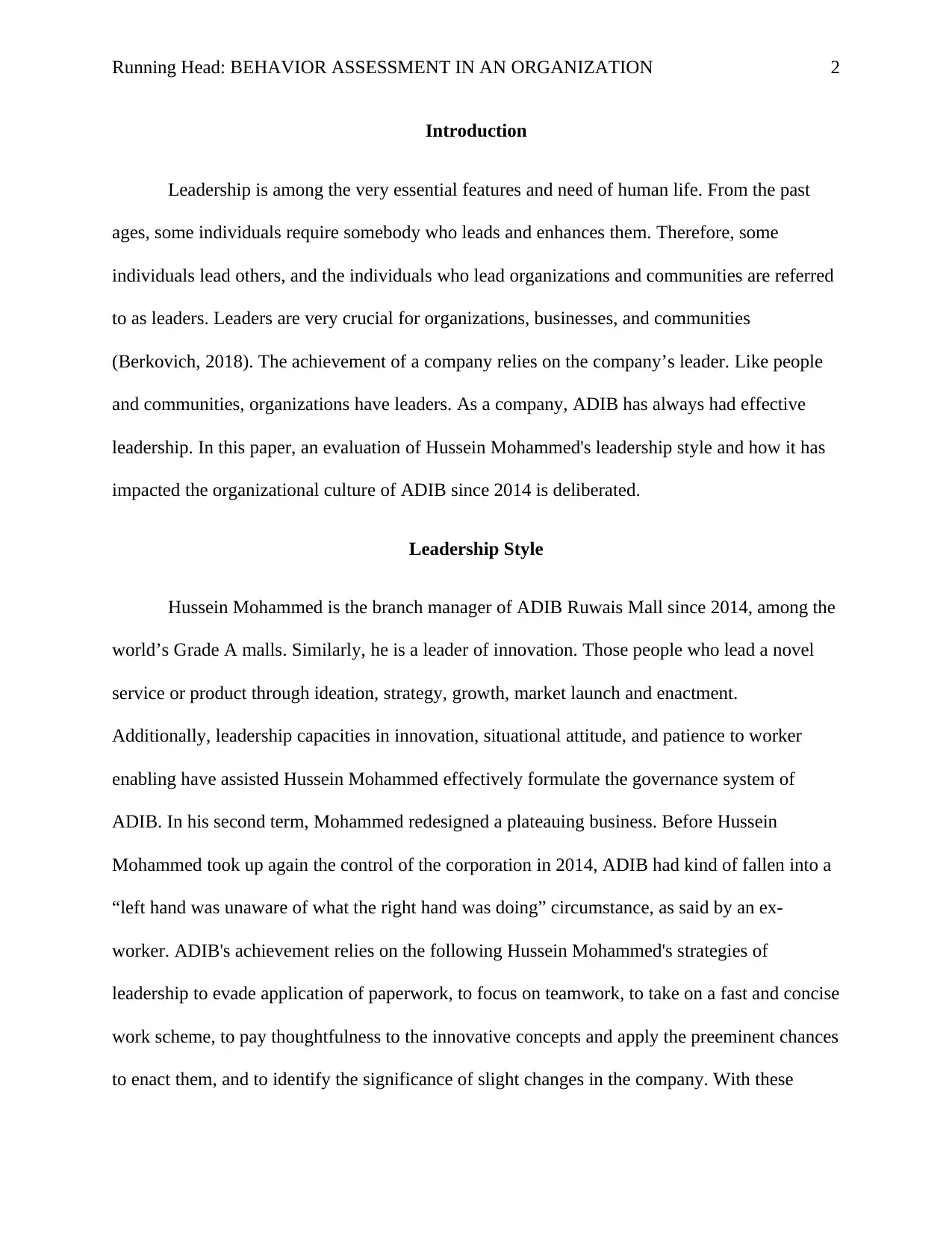
Running Head: BEHAVIOR ASSESSMENT IN AN ORGANIZATION 2
Introduction
Leadership is among the very essential features and need of human life. From the past
ages, some individuals require somebody who leads and enhances them. Therefore, some
individuals lead others, and the individuals who lead organizations and communities are referred
to as leaders. Leaders are very crucial for organizations, businesses, and communities
(Berkovich, 2018). The achievement of a company relies on the company’s leader. Like people
and communities, organizations have leaders. As a company, ADIB has always had effective
leadership. In this paper, an evaluation of Hussein Mohammed's leadership style and how it has
impacted the organizational culture of ADIB since 2014 is deliberated.
Leadership Style
Hussein Mohammed is the branch manager of ADIB Ruwais Mall since 2014, among the
world’s Grade A malls. Similarly, he is a leader of innovation. Those people who lead a novel
service or product through ideation, strategy, growth, market launch and enactment.
Additionally, leadership capacities in innovation, situational attitude, and patience to worker
enabling have assisted Hussein Mohammed effectively formulate the governance system of
ADIB. In his second term, Mohammed redesigned a plateauing business. Before Hussein
Mohammed took up again the control of the corporation in 2014, ADIB had kind of fallen into a
“left hand was unaware of what the right hand was doing” circumstance, as said by an ex-
worker. ADIB's achievement relies on the following Hussein Mohammed's strategies of
leadership to evade application of paperwork, to focus on teamwork, to take on a fast and concise
work scheme, to pay thoughtfulness to the innovative concepts and apply the preeminent chances
to enact them, and to identify the significance of slight changes in the company. With these
Introduction
Leadership is among the very essential features and need of human life. From the past
ages, some individuals require somebody who leads and enhances them. Therefore, some
individuals lead others, and the individuals who lead organizations and communities are referred
to as leaders. Leaders are very crucial for organizations, businesses, and communities
(Berkovich, 2018). The achievement of a company relies on the company’s leader. Like people
and communities, organizations have leaders. As a company, ADIB has always had effective
leadership. In this paper, an evaluation of Hussein Mohammed's leadership style and how it has
impacted the organizational culture of ADIB since 2014 is deliberated.
Leadership Style
Hussein Mohammed is the branch manager of ADIB Ruwais Mall since 2014, among the
world’s Grade A malls. Similarly, he is a leader of innovation. Those people who lead a novel
service or product through ideation, strategy, growth, market launch and enactment.
Additionally, leadership capacities in innovation, situational attitude, and patience to worker
enabling have assisted Hussein Mohammed effectively formulate the governance system of
ADIB. In his second term, Mohammed redesigned a plateauing business. Before Hussein
Mohammed took up again the control of the corporation in 2014, ADIB had kind of fallen into a
“left hand was unaware of what the right hand was doing” circumstance, as said by an ex-
worker. ADIB's achievement relies on the following Hussein Mohammed's strategies of
leadership to evade application of paperwork, to focus on teamwork, to take on a fast and concise
work scheme, to pay thoughtfulness to the innovative concepts and apply the preeminent chances
to enact them, and to identify the significance of slight changes in the company. With these
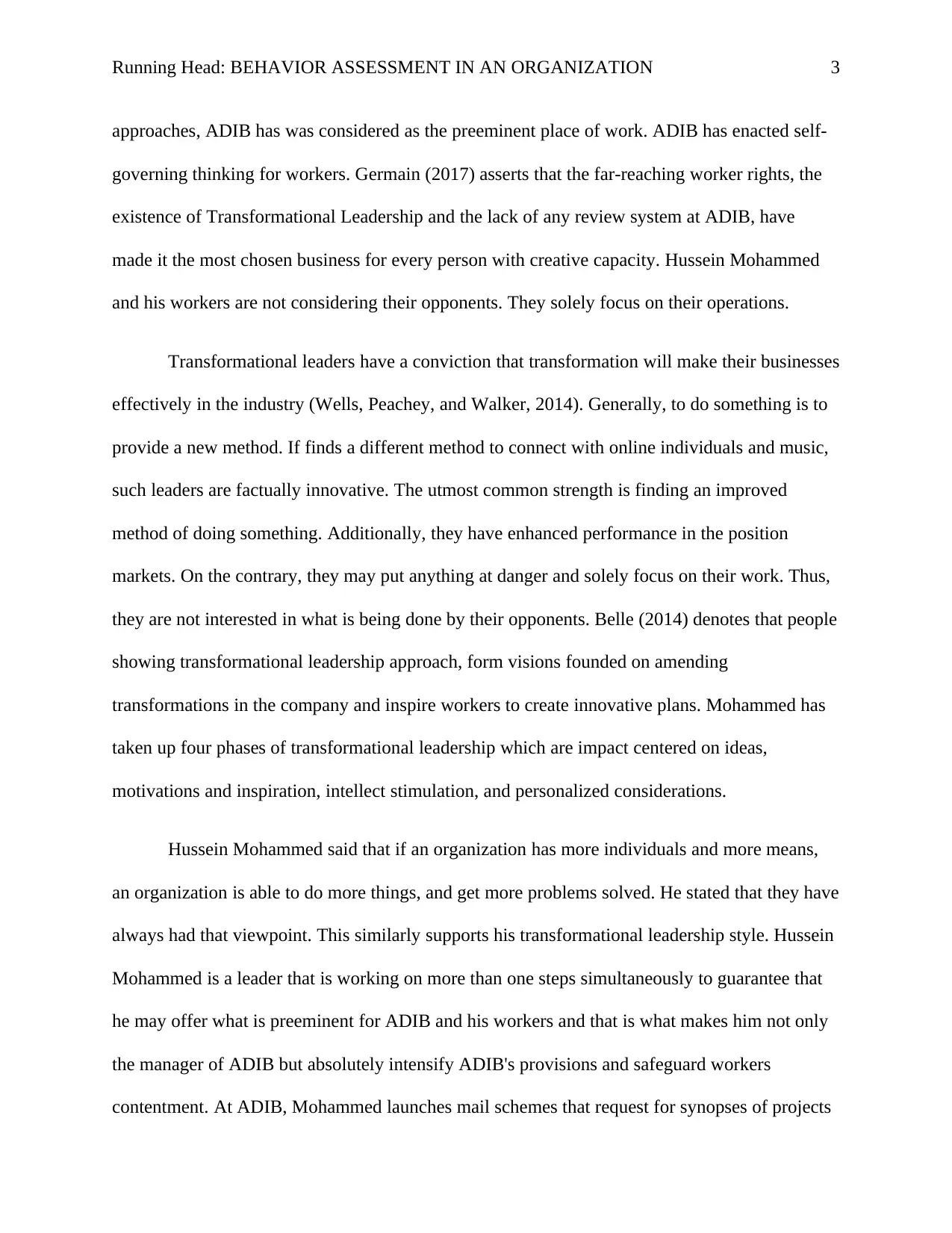
Running Head: BEHAVIOR ASSESSMENT IN AN ORGANIZATION 3
approaches, ADIB has was considered as the preeminent place of work. ADIB has enacted self-
governing thinking for workers. Germain (2017) asserts that the far-reaching worker rights, the
existence of Transformational Leadership and the lack of any review system at ADIB, have
made it the most chosen business for every person with creative capacity. Hussein Mohammed
and his workers are not considering their opponents. They solely focus on their operations.
Transformational leaders have a conviction that transformation will make their businesses
effectively in the industry (Wells, Peachey, and Walker, 2014). Generally, to do something is to
provide a new method. If finds a different method to connect with online individuals and music,
such leaders are factually innovative. The utmost common strength is finding an improved
method of doing something. Additionally, they have enhanced performance in the position
markets. On the contrary, they may put anything at danger and solely focus on their work. Thus,
they are not interested in what is being done by their opponents. Belle (2014) denotes that people
showing transformational leadership approach, form visions founded on amending
transformations in the company and inspire workers to create innovative plans. Mohammed has
taken up four phases of transformational leadership which are impact centered on ideas,
motivations and inspiration, intellect stimulation, and personalized considerations.
Hussein Mohammed said that if an organization has more individuals and more means,
an organization is able to do more things, and get more problems solved. He stated that they have
always had that viewpoint. This similarly supports his transformational leadership style. Hussein
Mohammed is a leader that is working on more than one steps simultaneously to guarantee that
he may offer what is preeminent for ADIB and his workers and that is what makes him not only
the manager of ADIB but absolutely intensify ADIB's provisions and safeguard workers
contentment. At ADIB, Mohammed launches mail schemes that request for synopses of projects
approaches, ADIB has was considered as the preeminent place of work. ADIB has enacted self-
governing thinking for workers. Germain (2017) asserts that the far-reaching worker rights, the
existence of Transformational Leadership and the lack of any review system at ADIB, have
made it the most chosen business for every person with creative capacity. Hussein Mohammed
and his workers are not considering their opponents. They solely focus on their operations.
Transformational leaders have a conviction that transformation will make their businesses
effectively in the industry (Wells, Peachey, and Walker, 2014). Generally, to do something is to
provide a new method. If finds a different method to connect with online individuals and music,
such leaders are factually innovative. The utmost common strength is finding an improved
method of doing something. Additionally, they have enhanced performance in the position
markets. On the contrary, they may put anything at danger and solely focus on their work. Thus,
they are not interested in what is being done by their opponents. Belle (2014) denotes that people
showing transformational leadership approach, form visions founded on amending
transformations in the company and inspire workers to create innovative plans. Mohammed has
taken up four phases of transformational leadership which are impact centered on ideas,
motivations and inspiration, intellect stimulation, and personalized considerations.
Hussein Mohammed said that if an organization has more individuals and more means,
an organization is able to do more things, and get more problems solved. He stated that they have
always had that viewpoint. This similarly supports his transformational leadership style. Hussein
Mohammed is a leader that is working on more than one steps simultaneously to guarantee that
he may offer what is preeminent for ADIB and his workers and that is what makes him not only
the manager of ADIB but absolutely intensify ADIB's provisions and safeguard workers
contentment. At ADIB, Mohammed launches mail schemes that request for synopses of projects
⊘ This is a preview!⊘
Do you want full access?
Subscribe today to unlock all pages.

Trusted by 1+ million students worldwide
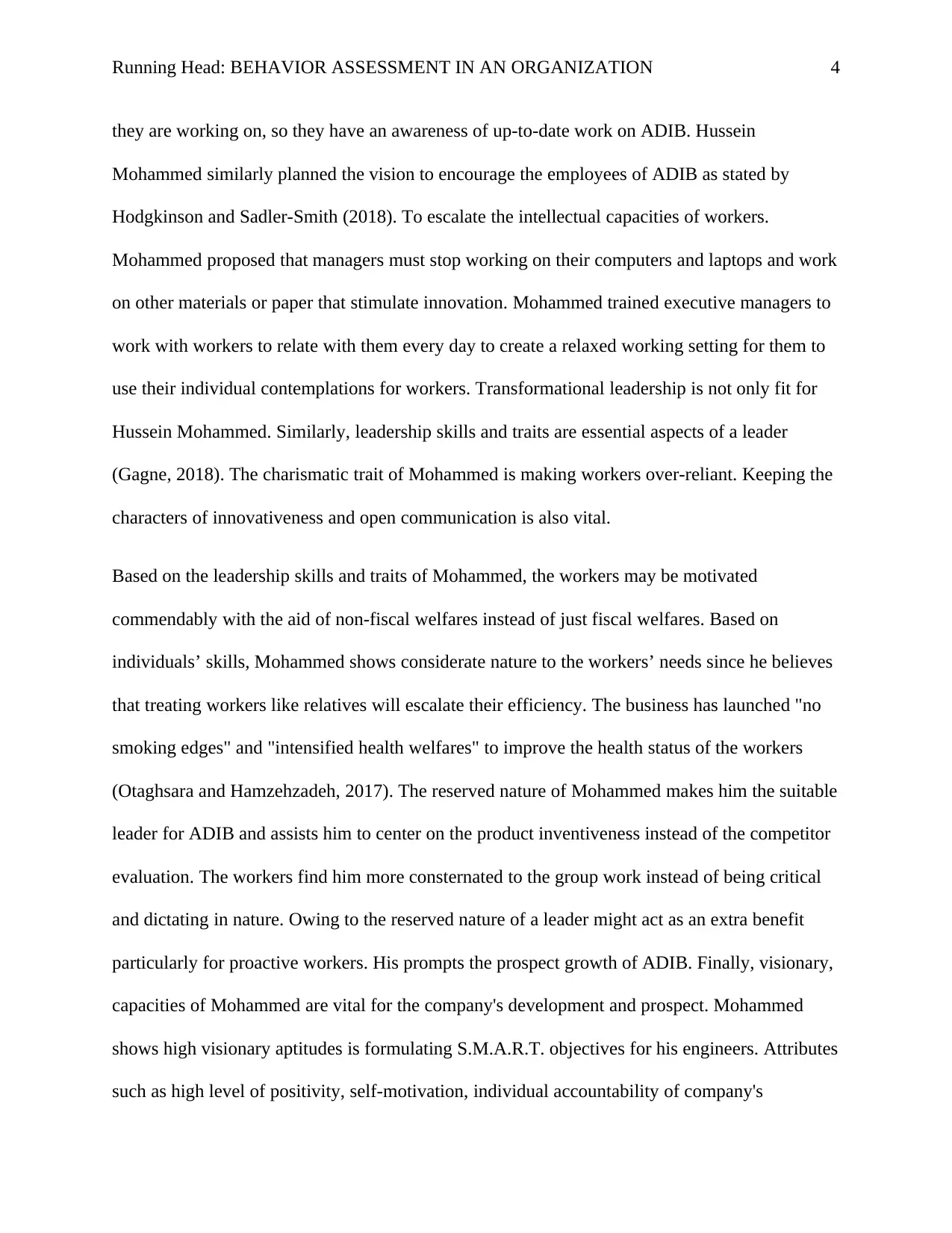
Running Head: BEHAVIOR ASSESSMENT IN AN ORGANIZATION 4
they are working on, so they have an awareness of up-to-date work on ADIB. Hussein
Mohammed similarly planned the vision to encourage the employees of ADIB as stated by
Hodgkinson and Sadler-Smith (2018). To escalate the intellectual capacities of workers.
Mohammed proposed that managers must stop working on their computers and laptops and work
on other materials or paper that stimulate innovation. Mohammed trained executive managers to
work with workers to relate with them every day to create a relaxed working setting for them to
use their individual contemplations for workers. Transformational leadership is not only fit for
Hussein Mohammed. Similarly, leadership skills and traits are essential aspects of a leader
(Gagne, 2018). The charismatic trait of Mohammed is making workers over-reliant. Keeping the
characters of innovativeness and open communication is also vital.
Based on the leadership skills and traits of Mohammed, the workers may be motivated
commendably with the aid of non-fiscal welfares instead of just fiscal welfares. Based on
individuals’ skills, Mohammed shows considerate nature to the workers’ needs since he believes
that treating workers like relatives will escalate their efficiency. The business has launched "no
smoking edges" and "intensified health welfares" to improve the health status of the workers
(Otaghsara and Hamzehzadeh, 2017). The reserved nature of Mohammed makes him the suitable
leader for ADIB and assists him to center on the product inventiveness instead of the competitor
evaluation. The workers find him more consternated to the group work instead of being critical
and dictating in nature. Owing to the reserved nature of a leader might act as an extra benefit
particularly for proactive workers. His prompts the prospect growth of ADIB. Finally, visionary,
capacities of Mohammed are vital for the company's development and prospect. Mohammed
shows high visionary aptitudes is formulating S.M.A.R.T. objectives for his engineers. Attributes
such as high level of positivity, self-motivation, individual accountability of company's
they are working on, so they have an awareness of up-to-date work on ADIB. Hussein
Mohammed similarly planned the vision to encourage the employees of ADIB as stated by
Hodgkinson and Sadler-Smith (2018). To escalate the intellectual capacities of workers.
Mohammed proposed that managers must stop working on their computers and laptops and work
on other materials or paper that stimulate innovation. Mohammed trained executive managers to
work with workers to relate with them every day to create a relaxed working setting for them to
use their individual contemplations for workers. Transformational leadership is not only fit for
Hussein Mohammed. Similarly, leadership skills and traits are essential aspects of a leader
(Gagne, 2018). The charismatic trait of Mohammed is making workers over-reliant. Keeping the
characters of innovativeness and open communication is also vital.
Based on the leadership skills and traits of Mohammed, the workers may be motivated
commendably with the aid of non-fiscal welfares instead of just fiscal welfares. Based on
individuals’ skills, Mohammed shows considerate nature to the workers’ needs since he believes
that treating workers like relatives will escalate their efficiency. The business has launched "no
smoking edges" and "intensified health welfares" to improve the health status of the workers
(Otaghsara and Hamzehzadeh, 2017). The reserved nature of Mohammed makes him the suitable
leader for ADIB and assists him to center on the product inventiveness instead of the competitor
evaluation. The workers find him more consternated to the group work instead of being critical
and dictating in nature. Owing to the reserved nature of a leader might act as an extra benefit
particularly for proactive workers. His prompts the prospect growth of ADIB. Finally, visionary,
capacities of Mohammed are vital for the company's development and prospect. Mohammed
shows high visionary aptitudes is formulating S.M.A.R.T. objectives for his engineers. Attributes
such as high level of positivity, self-motivation, individual accountability of company's
Paraphrase This Document
Need a fresh take? Get an instant paraphrase of this document with our AI Paraphraser

Running Head: BEHAVIOR ASSESSMENT IN AN ORGANIZATION 5
activities, activities familiarization, integrity skills, and trustworthiness and regarding all
negative situations as a winning situation, make Mohammed a modest visionary leader.
Organizational Culture
According to Kim, Ployhart, and Gibson (2018), ADIB possesses an organizational
culture for innovation. The corporation similarly highlights the significance of openness amongst
workers, as a means of stimulating an innovative attitude. The resultant innovation relates to
ADIB’s methods in competing in several industries. For example, the company invents its
technological resources and services offered to clients in the online promotion industry. Features
that designate ADIB’s company culture are innovation, hands-on method, openness, small-
company-family provision, and brilliance that comes with elegance.
Innovation is an essential achievement aspect of ADIB's company. The corporate's
organizational culture inspires workers to add to the general innovation of the company and its
products. For instance, this cultural feature upholds workers' out-of-the-box thinking to find or
conceive different solutions to contemporary or emergent requirements in the international
market. Innovation adds to company efficiency in looking into the tendencies listed in the
PESTEL evaluation of ADIB LLC (Bauer, Wright, Askew, and Spector, 2018). This situation
similarly implies that the corporate's kinds and degrees of innovation vary based on the
important needs recognized in the information technology and services market.
Through its company culture, ADIB uses a hands-on method to human resource
advancement. It centers on applying experimental learning as an efficient method of enhancing
workers’ awareness, abilities, and skills. Theoretical awareness is not good enough for the
company. Employees are projected to learn as they progress in their journey as part of
activities, activities familiarization, integrity skills, and trustworthiness and regarding all
negative situations as a winning situation, make Mohammed a modest visionary leader.
Organizational Culture
According to Kim, Ployhart, and Gibson (2018), ADIB possesses an organizational
culture for innovation. The corporation similarly highlights the significance of openness amongst
workers, as a means of stimulating an innovative attitude. The resultant innovation relates to
ADIB’s methods in competing in several industries. For example, the company invents its
technological resources and services offered to clients in the online promotion industry. Features
that designate ADIB’s company culture are innovation, hands-on method, openness, small-
company-family provision, and brilliance that comes with elegance.
Innovation is an essential achievement aspect of ADIB's company. The corporate's
organizational culture inspires workers to add to the general innovation of the company and its
products. For instance, this cultural feature upholds workers' out-of-the-box thinking to find or
conceive different solutions to contemporary or emergent requirements in the international
market. Innovation adds to company efficiency in looking into the tendencies listed in the
PESTEL evaluation of ADIB LLC (Bauer, Wright, Askew, and Spector, 2018). This situation
similarly implies that the corporate's kinds and degrees of innovation vary based on the
important needs recognized in the information technology and services market.
Through its company culture, ADIB uses a hands-on method to human resource
advancement. It centers on applying experimental learning as an efficient method of enhancing
workers’ awareness, abilities, and skills. Theoretical awareness is not good enough for the
company. Employees are projected to learn as they progress in their journey as part of
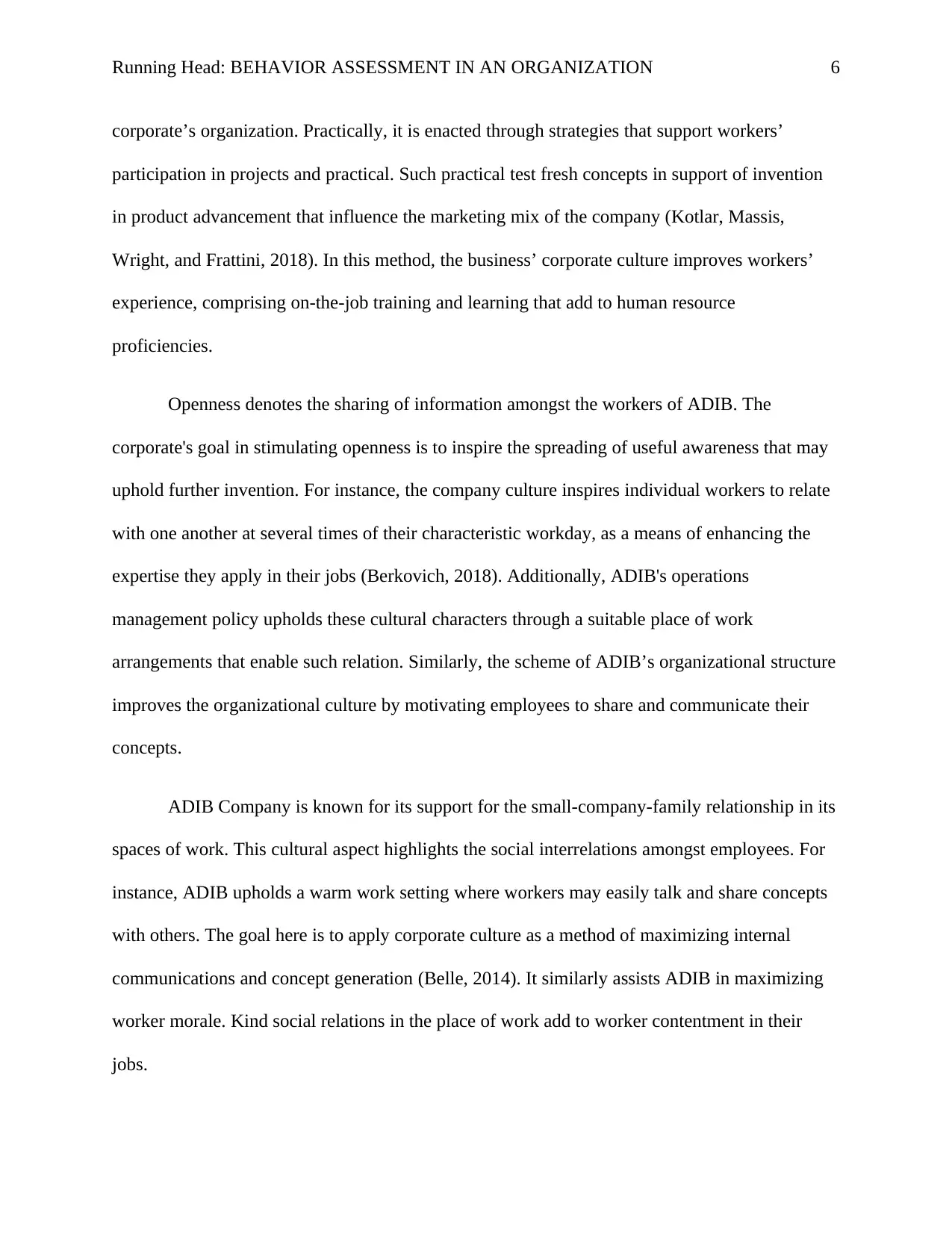
Running Head: BEHAVIOR ASSESSMENT IN AN ORGANIZATION 6
corporate’s organization. Practically, it is enacted through strategies that support workers’
participation in projects and practical. Such practical test fresh concepts in support of invention
in product advancement that influence the marketing mix of the company (Kotlar, Massis,
Wright, and Frattini, 2018). In this method, the business’ corporate culture improves workers’
experience, comprising on-the-job training and learning that add to human resource
proficiencies.
Openness denotes the sharing of information amongst the workers of ADIB. The
corporate's goal in stimulating openness is to inspire the spreading of useful awareness that may
uphold further invention. For instance, the company culture inspires individual workers to relate
with one another at several times of their characteristic workday, as a means of enhancing the
expertise they apply in their jobs (Berkovich, 2018). Additionally, ADIB's operations
management policy upholds these cultural characters through a suitable place of work
arrangements that enable such relation. Similarly, the scheme of ADIB’s organizational structure
improves the organizational culture by motivating employees to share and communicate their
concepts.
ADIB Company is known for its support for the small-company-family relationship in its
spaces of work. This cultural aspect highlights the social interrelations amongst employees. For
instance, ADIB upholds a warm work setting where workers may easily talk and share concepts
with others. The goal here is to apply corporate culture as a method of maximizing internal
communications and concept generation (Belle, 2014). It similarly assists ADIB in maximizing
worker morale. Kind social relations in the place of work add to worker contentment in their
jobs.
corporate’s organization. Practically, it is enacted through strategies that support workers’
participation in projects and practical. Such practical test fresh concepts in support of invention
in product advancement that influence the marketing mix of the company (Kotlar, Massis,
Wright, and Frattini, 2018). In this method, the business’ corporate culture improves workers’
experience, comprising on-the-job training and learning that add to human resource
proficiencies.
Openness denotes the sharing of information amongst the workers of ADIB. The
corporate's goal in stimulating openness is to inspire the spreading of useful awareness that may
uphold further invention. For instance, the company culture inspires individual workers to relate
with one another at several times of their characteristic workday, as a means of enhancing the
expertise they apply in their jobs (Berkovich, 2018). Additionally, ADIB's operations
management policy upholds these cultural characters through a suitable place of work
arrangements that enable such relation. Similarly, the scheme of ADIB’s organizational structure
improves the organizational culture by motivating employees to share and communicate their
concepts.
ADIB Company is known for its support for the small-company-family relationship in its
spaces of work. This cultural aspect highlights the social interrelations amongst employees. For
instance, ADIB upholds a warm work setting where workers may easily talk and share concepts
with others. The goal here is to apply corporate culture as a method of maximizing internal
communications and concept generation (Belle, 2014). It similarly assists ADIB in maximizing
worker morale. Kind social relations in the place of work add to worker contentment in their
jobs.
⊘ This is a preview!⊘
Do you want full access?
Subscribe today to unlock all pages.

Trusted by 1+ million students worldwide

Running Head: BEHAVIOR ASSESSMENT IN AN ORGANIZATION 7
Brilliance highlights attaining brilliant results from all capacities of ADIB's business. It is
integrated into human resource development platforms to instruct an understanding of brilliance
amongst workers. For instance, training platforms are formed to inspire employees to constantly
enhance their productivity, and to not be content with ordinary results. Thus ADIB's company
culture upholds smartness in the team and pushes workers to strive for brilliant work.
Effect of Leadership on Organizational Culture
An important aspect of any organization whether small or large is to outline their key
value, the principles that are most essential to the direction of the company and the choice in it
should be openly stated for the organization to attain its goal. Germain (2017) asserts that for a
company to be successful, the manager's value should be in connection to the company value to
evade conflict of interest between the company and the manager. Analyzing the leadership style
of an effective manager, we discover that many of them have similar values to that of the
organization as seen in their achievement secret. Mohammed's individual principle was closely
linked to that of ADIB and this has reflected the overwhelming accomplishment that was
enumerated as him as a manager of one of the prominent companies globally. Mohammed has a
principle of working with the most intelligent and brightest individuals globally and which is
amongst the key values of ADIB as a company.
Recommendations and Conclusion
According to Gagne (2018), a likely improvement to the organizational culture is the
extra escalation of information sharing. Presently, even though the organization’s cultural
features support information sharing and communications, such sharing happens in a controlled
way. ADIB may heighten workers’ rate of independence in this consideration, to exploit the
Brilliance highlights attaining brilliant results from all capacities of ADIB's business. It is
integrated into human resource development platforms to instruct an understanding of brilliance
amongst workers. For instance, training platforms are formed to inspire employees to constantly
enhance their productivity, and to not be content with ordinary results. Thus ADIB's company
culture upholds smartness in the team and pushes workers to strive for brilliant work.
Effect of Leadership on Organizational Culture
An important aspect of any organization whether small or large is to outline their key
value, the principles that are most essential to the direction of the company and the choice in it
should be openly stated for the organization to attain its goal. Germain (2017) asserts that for a
company to be successful, the manager's value should be in connection to the company value to
evade conflict of interest between the company and the manager. Analyzing the leadership style
of an effective manager, we discover that many of them have similar values to that of the
organization as seen in their achievement secret. Mohammed's individual principle was closely
linked to that of ADIB and this has reflected the overwhelming accomplishment that was
enumerated as him as a manager of one of the prominent companies globally. Mohammed has a
principle of working with the most intelligent and brightest individuals globally and which is
amongst the key values of ADIB as a company.
Recommendations and Conclusion
According to Gagne (2018), a likely improvement to the organizational culture is the
extra escalation of information sharing. Presently, even though the organization’s cultural
features support information sharing and communications, such sharing happens in a controlled
way. ADIB may heighten workers’ rate of independence in this consideration, to exploit the
Paraphrase This Document
Need a fresh take? Get an instant paraphrase of this document with our AI Paraphraser
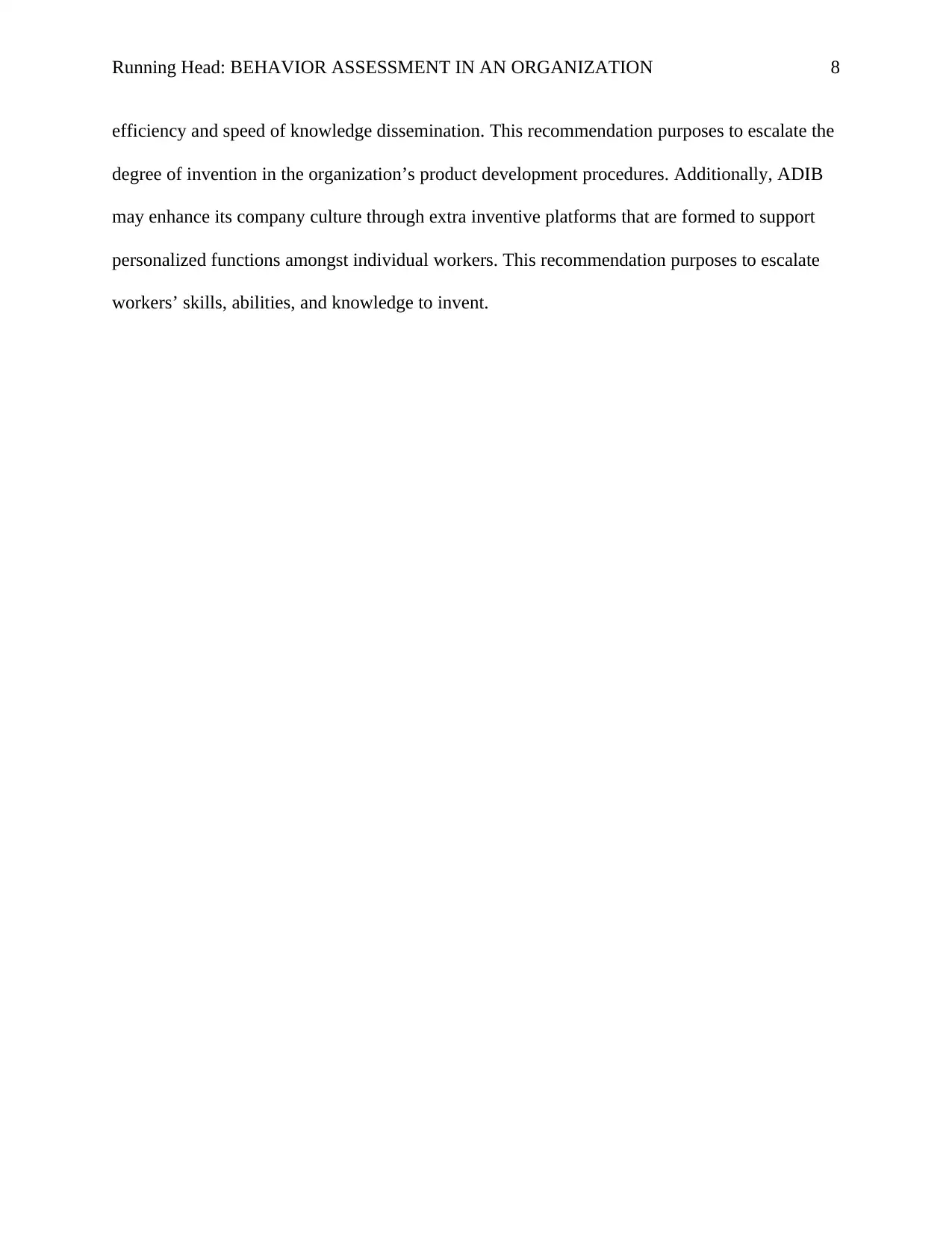
Running Head: BEHAVIOR ASSESSMENT IN AN ORGANIZATION 8
efficiency and speed of knowledge dissemination. This recommendation purposes to escalate the
degree of invention in the organization’s product development procedures. Additionally, ADIB
may enhance its company culture through extra inventive platforms that are formed to support
personalized functions amongst individual workers. This recommendation purposes to escalate
workers’ skills, abilities, and knowledge to invent.
efficiency and speed of knowledge dissemination. This recommendation purposes to escalate the
degree of invention in the organization’s product development procedures. Additionally, ADIB
may enhance its company culture through extra inventive platforms that are formed to support
personalized functions amongst individual workers. This recommendation purposes to escalate
workers’ skills, abilities, and knowledge to invent.

Running Head: BEHAVIOR ASSESSMENT IN AN ORGANIZATION 9
Introduction
The behavior exhibited by employees in an organization, is very significant in
determining the future of the organization. Employees who are determined and motivated
undertake their duties seriously and professionally as a way to reciprocate their appreciation and
commitment for their job. Lack of motivation in an organization leads to boredom which
hampers the performance of the employees whether they are professionals or in the skilled labor
sector. This therefore means, for an organization to be effective, efficient and produce the
desired results motivation should be considered at all times whether intrinsic or extrinsic. This
essay analyses one content and one process motivational theories and how they can be
effectively applied for better outcomes in an organization.
Analysis of the Theories
Maslow’s hierarchy of needs theory
The Hierarchy of needs theory of Abraham Maslow outlines the various needs of human
beings. He gives five levels of needs that should be met for better performance. According to
Stewart, Nodoushani and Stumpf (2018) physiological needs e.g. sleeping and hunger has to be
met first. Safety needs such as security and freedom from pain are important since an individual
cannot function in the absence. The social needs then follow as an individual naturally requires
love and affection. Esteem needs are also very significant since all people feel good when they
are respected. Self-actualization needs are then desired by each individual so as to develop full
potential.
The diagram below shows the hierarchy
Introduction
The behavior exhibited by employees in an organization, is very significant in
determining the future of the organization. Employees who are determined and motivated
undertake their duties seriously and professionally as a way to reciprocate their appreciation and
commitment for their job. Lack of motivation in an organization leads to boredom which
hampers the performance of the employees whether they are professionals or in the skilled labor
sector. This therefore means, for an organization to be effective, efficient and produce the
desired results motivation should be considered at all times whether intrinsic or extrinsic. This
essay analyses one content and one process motivational theories and how they can be
effectively applied for better outcomes in an organization.
Analysis of the Theories
Maslow’s hierarchy of needs theory
The Hierarchy of needs theory of Abraham Maslow outlines the various needs of human
beings. He gives five levels of needs that should be met for better performance. According to
Stewart, Nodoushani and Stumpf (2018) physiological needs e.g. sleeping and hunger has to be
met first. Safety needs such as security and freedom from pain are important since an individual
cannot function in the absence. The social needs then follow as an individual naturally requires
love and affection. Esteem needs are also very significant since all people feel good when they
are respected. Self-actualization needs are then desired by each individual so as to develop full
potential.
The diagram below shows the hierarchy
⊘ This is a preview!⊘
Do you want full access?
Subscribe today to unlock all pages.

Trusted by 1+ million students worldwide
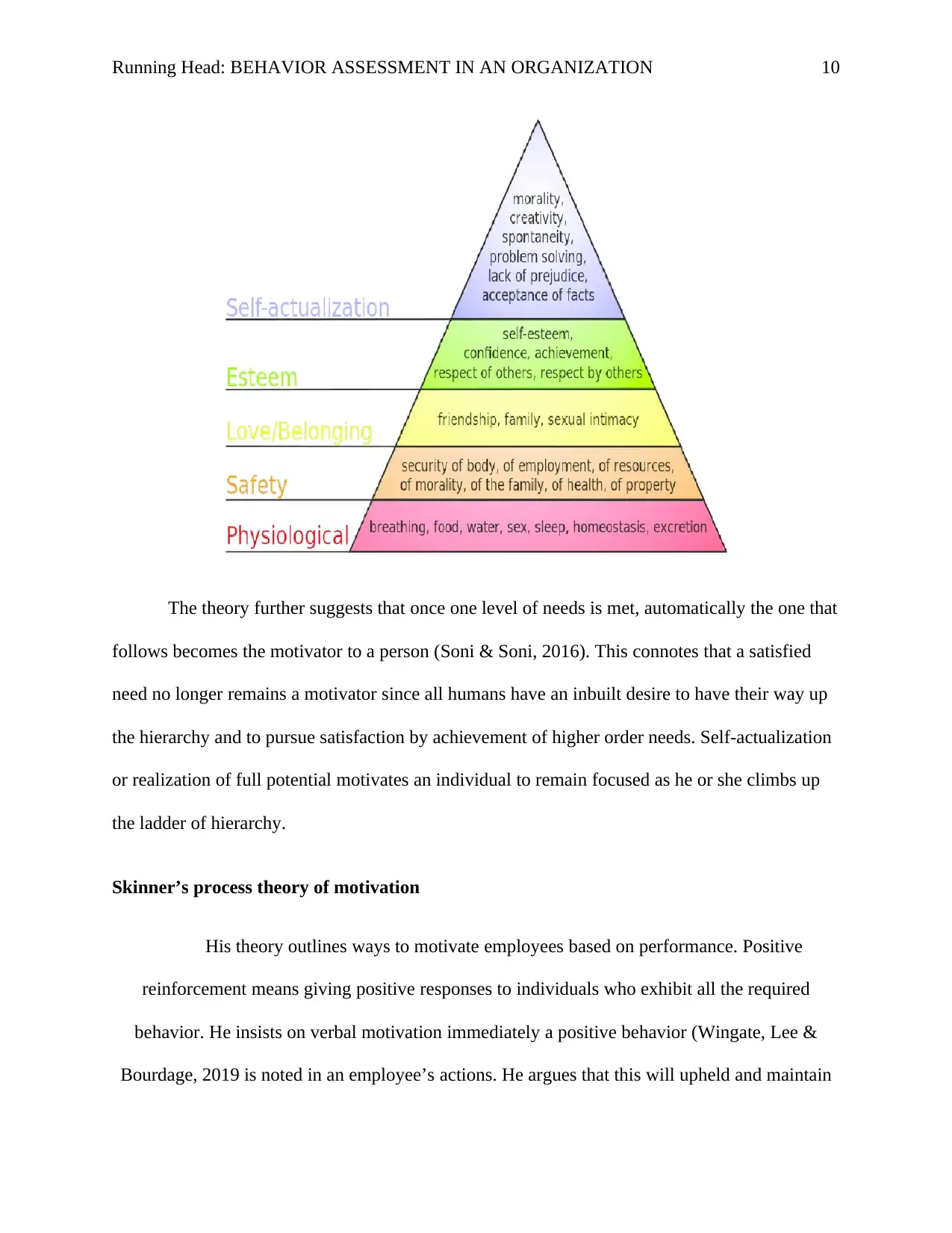
Running Head: BEHAVIOR ASSESSMENT IN AN ORGANIZATION 10
The theory further suggests that once one level of needs is met, automatically the one that
follows becomes the motivator to a person (Soni & Soni, 2016). This connotes that a satisfied
need no longer remains a motivator since all humans have an inbuilt desire to have their way up
the hierarchy and to pursue satisfaction by achievement of higher order needs. Self-actualization
or realization of full potential motivates an individual to remain focused as he or she climbs up
the ladder of hierarchy.
Skinner’s process theory of motivation
His theory outlines ways to motivate employees based on performance. Positive
reinforcement means giving positive responses to individuals who exhibit all the required
behavior. He insists on verbal motivation immediately a positive behavior (Wingate, Lee &
Bourdage, 2019 is noted in an employee’s actions. He argues that this will upheld and maintain
The theory further suggests that once one level of needs is met, automatically the one that
follows becomes the motivator to a person (Soni & Soni, 2016). This connotes that a satisfied
need no longer remains a motivator since all humans have an inbuilt desire to have their way up
the hierarchy and to pursue satisfaction by achievement of higher order needs. Self-actualization
or realization of full potential motivates an individual to remain focused as he or she climbs up
the ladder of hierarchy.
Skinner’s process theory of motivation
His theory outlines ways to motivate employees based on performance. Positive
reinforcement means giving positive responses to individuals who exhibit all the required
behavior. He insists on verbal motivation immediately a positive behavior (Wingate, Lee &
Bourdage, 2019 is noted in an employee’s actions. He argues that this will upheld and maintain
Paraphrase This Document
Need a fresh take? Get an instant paraphrase of this document with our AI Paraphraser
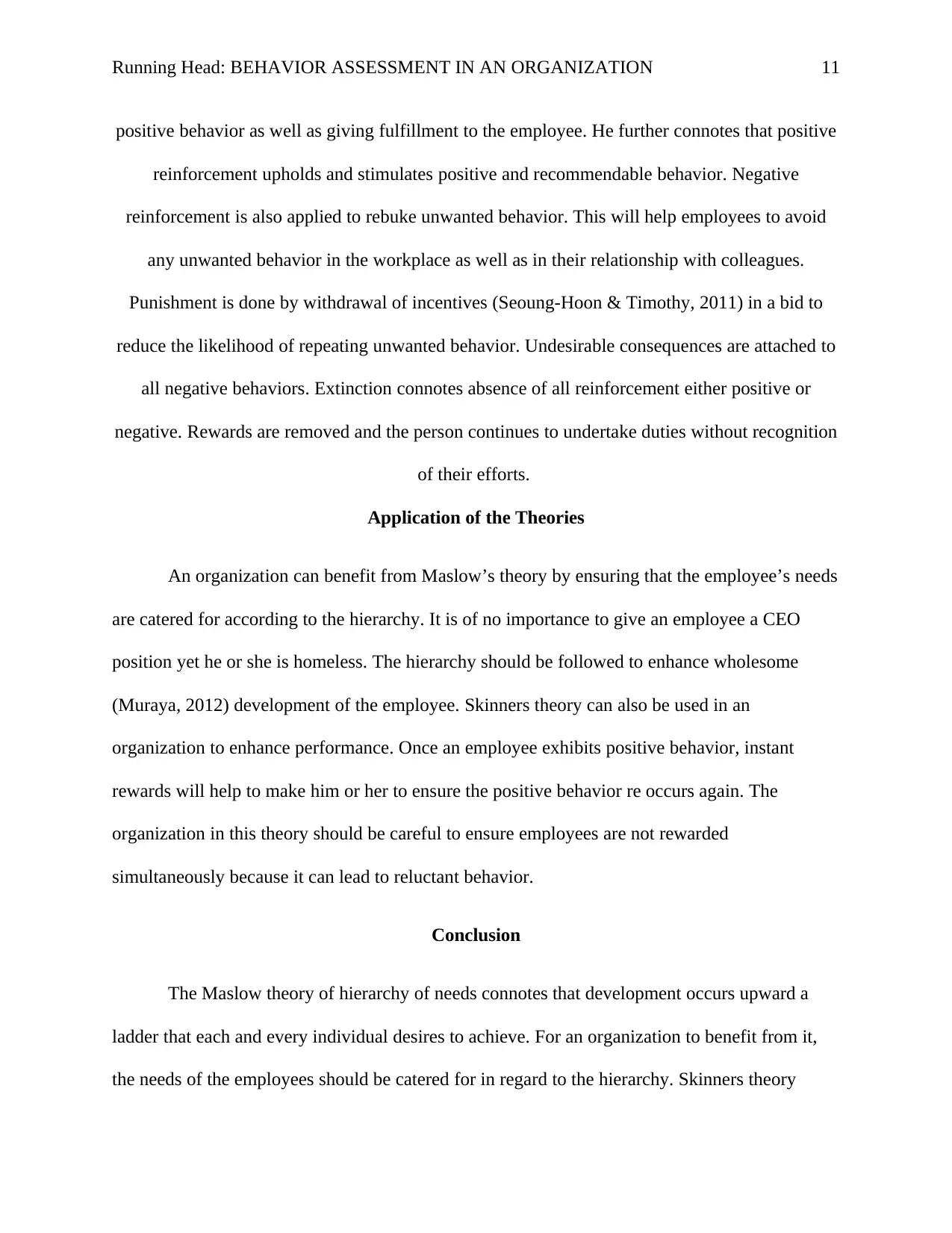
Running Head: BEHAVIOR ASSESSMENT IN AN ORGANIZATION 11
positive behavior as well as giving fulfillment to the employee. He further connotes that positive
reinforcement upholds and stimulates positive and recommendable behavior. Negative
reinforcement is also applied to rebuke unwanted behavior. This will help employees to avoid
any unwanted behavior in the workplace as well as in their relationship with colleagues.
Punishment is done by withdrawal of incentives (Seoung-Hoon & Timothy, 2011) in a bid to
reduce the likelihood of repeating unwanted behavior. Undesirable consequences are attached to
all negative behaviors. Extinction connotes absence of all reinforcement either positive or
negative. Rewards are removed and the person continues to undertake duties without recognition
of their efforts.
Application of the Theories
An organization can benefit from Maslow’s theory by ensuring that the employee’s needs
are catered for according to the hierarchy. It is of no importance to give an employee a CEO
position yet he or she is homeless. The hierarchy should be followed to enhance wholesome
(Muraya, 2012) development of the employee. Skinners theory can also be used in an
organization to enhance performance. Once an employee exhibits positive behavior, instant
rewards will help to make him or her to ensure the positive behavior re occurs again. The
organization in this theory should be careful to ensure employees are not rewarded
simultaneously because it can lead to reluctant behavior.
Conclusion
The Maslow theory of hierarchy of needs connotes that development occurs upward a
ladder that each and every individual desires to achieve. For an organization to benefit from it,
the needs of the employees should be catered for in regard to the hierarchy. Skinners theory
positive behavior as well as giving fulfillment to the employee. He further connotes that positive
reinforcement upholds and stimulates positive and recommendable behavior. Negative
reinforcement is also applied to rebuke unwanted behavior. This will help employees to avoid
any unwanted behavior in the workplace as well as in their relationship with colleagues.
Punishment is done by withdrawal of incentives (Seoung-Hoon & Timothy, 2011) in a bid to
reduce the likelihood of repeating unwanted behavior. Undesirable consequences are attached to
all negative behaviors. Extinction connotes absence of all reinforcement either positive or
negative. Rewards are removed and the person continues to undertake duties without recognition
of their efforts.
Application of the Theories
An organization can benefit from Maslow’s theory by ensuring that the employee’s needs
are catered for according to the hierarchy. It is of no importance to give an employee a CEO
position yet he or she is homeless. The hierarchy should be followed to enhance wholesome
(Muraya, 2012) development of the employee. Skinners theory can also be used in an
organization to enhance performance. Once an employee exhibits positive behavior, instant
rewards will help to make him or her to ensure the positive behavior re occurs again. The
organization in this theory should be careful to ensure employees are not rewarded
simultaneously because it can lead to reluctant behavior.
Conclusion
The Maslow theory of hierarchy of needs connotes that development occurs upward a
ladder that each and every individual desires to achieve. For an organization to benefit from it,
the needs of the employees should be catered for in regard to the hierarchy. Skinners theory
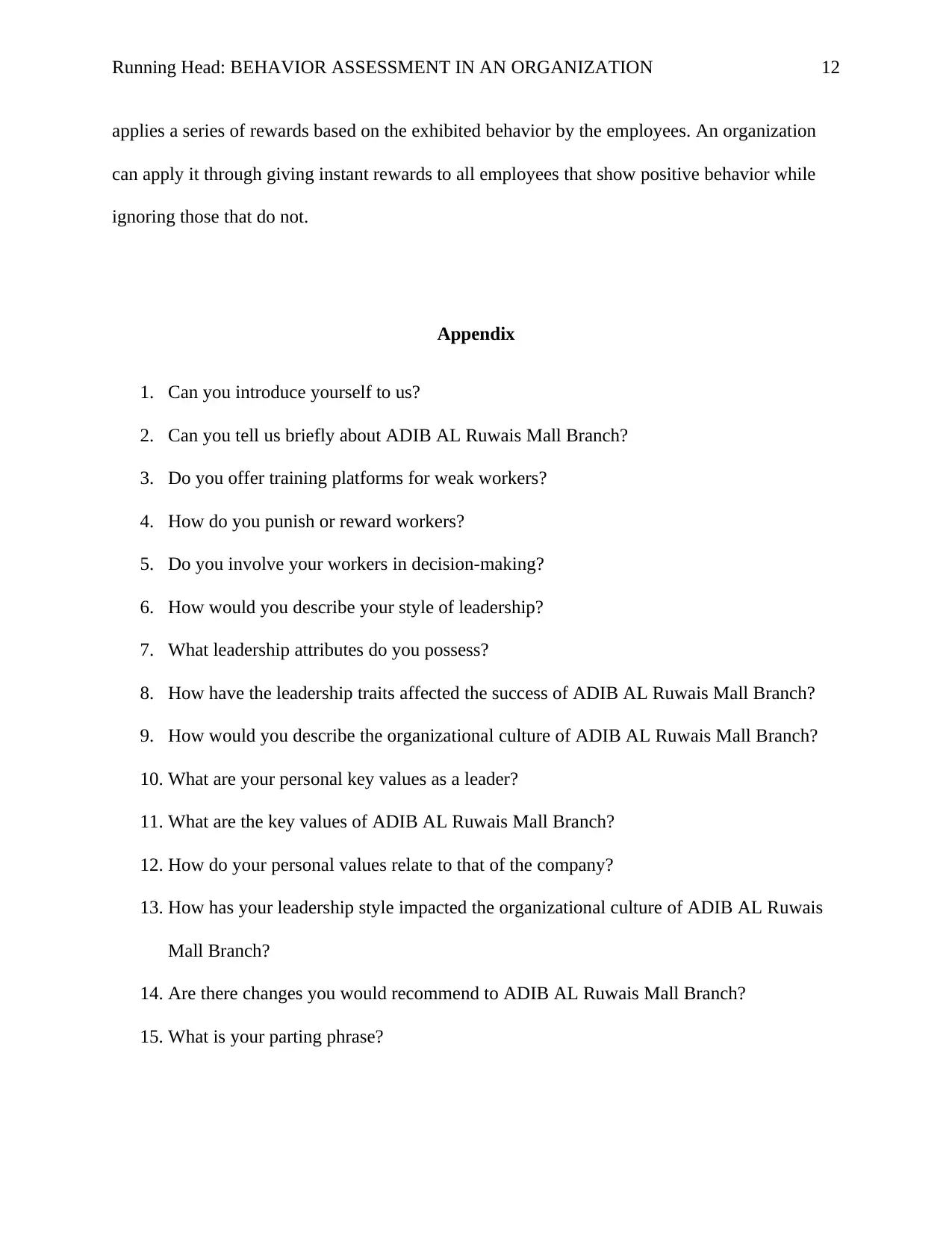
Running Head: BEHAVIOR ASSESSMENT IN AN ORGANIZATION 12
applies a series of rewards based on the exhibited behavior by the employees. An organization
can apply it through giving instant rewards to all employees that show positive behavior while
ignoring those that do not.
Appendix
1. Can you introduce yourself to us?
2. Can you tell us briefly about ADIB AL Ruwais Mall Branch?
3. Do you offer training platforms for weak workers?
4. How do you punish or reward workers?
5. Do you involve your workers in decision-making?
6. How would you describe your style of leadership?
7. What leadership attributes do you possess?
8. How have the leadership traits affected the success of ADIB AL Ruwais Mall Branch?
9. How would you describe the organizational culture of ADIB AL Ruwais Mall Branch?
10. What are your personal key values as a leader?
11. What are the key values of ADIB AL Ruwais Mall Branch?
12. How do your personal values relate to that of the company?
13. How has your leadership style impacted the organizational culture of ADIB AL Ruwais
Mall Branch?
14. Are there changes you would recommend to ADIB AL Ruwais Mall Branch?
15. What is your parting phrase?
applies a series of rewards based on the exhibited behavior by the employees. An organization
can apply it through giving instant rewards to all employees that show positive behavior while
ignoring those that do not.
Appendix
1. Can you introduce yourself to us?
2. Can you tell us briefly about ADIB AL Ruwais Mall Branch?
3. Do you offer training platforms for weak workers?
4. How do you punish or reward workers?
5. Do you involve your workers in decision-making?
6. How would you describe your style of leadership?
7. What leadership attributes do you possess?
8. How have the leadership traits affected the success of ADIB AL Ruwais Mall Branch?
9. How would you describe the organizational culture of ADIB AL Ruwais Mall Branch?
10. What are your personal key values as a leader?
11. What are the key values of ADIB AL Ruwais Mall Branch?
12. How do your personal values relate to that of the company?
13. How has your leadership style impacted the organizational culture of ADIB AL Ruwais
Mall Branch?
14. Are there changes you would recommend to ADIB AL Ruwais Mall Branch?
15. What is your parting phrase?
⊘ This is a preview!⊘
Do you want full access?
Subscribe today to unlock all pages.

Trusted by 1+ million students worldwide
1 out of 15
Your All-in-One AI-Powered Toolkit for Academic Success.
+13062052269
info@desklib.com
Available 24*7 on WhatsApp / Email
![[object Object]](/_next/static/media/star-bottom.7253800d.svg)
Unlock your academic potential
Copyright © 2020–2025 A2Z Services. All Rights Reserved. Developed and managed by ZUCOL.


